‘Hitler in Los Angeles’ Offers Lessons in the Fight Against Bigotry
The story of Jewish resistance to the large numbers of Nazis and fascists in Los Angeles during the 1930s and early ’40s is a reminder to remain vigilant.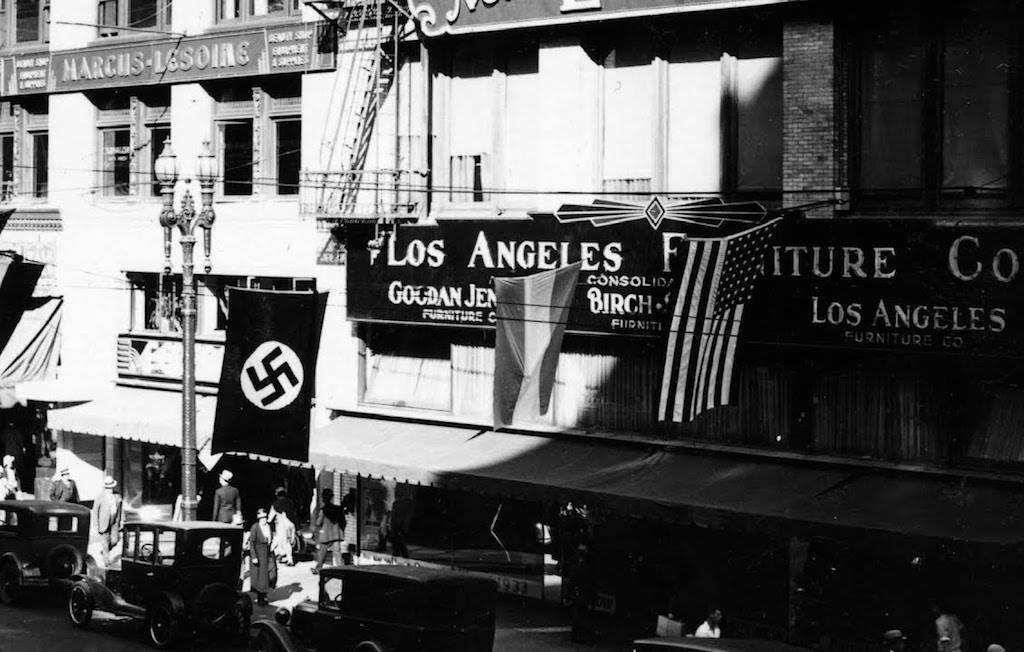 A Nazi flag hangs outside a store in downtown Los Angeles in 1936. (Screen shot via YouTube)
A Nazi flag hangs outside a store in downtown Los Angeles in 1936. (Screen shot via YouTube)
“Hitler in Los Angeles: How Jews Foiled Nazi Plots Against Hollywood and America”
A book by Steven Ross
“The Jews will not replace us.
Blood and soil.”
—Neo-Nazi slogans, Charlottesville, Va., August 2017
“You also had some very fine people on both sides.”
—Donald Trump in response to Charlottesville, Va., protests, August 2017
Like millions of people throughout America and the world, I was riveted by the events in Charlottesville, Virginia, in August 2017. But seeing Nazi flags and people chanting Nazi slogans as they marched—ostensibly to preserve the statue of a treasonous general—was more than unnerving. The swastika was the symbol under which 6 million Jews and millions of other people were murdered, including my grandparents, aunt and uncle, all of whom I never knew.
The Confederate flag was also prominently on display—another racist marker associated with murder and untold human horror and suffering. This also dismayed me in tremendously visceral ways. I saw that grotesque symbol hundreds, maybe thousands, of times during my civil rights work in both the North and the South. More important, I saw the twisted face of bigotry then, as racists called my African-American friends and fellow activists vile epithets.
It pains me to realize that even now, we have Nazis and white racists from the Ku Klux Klan and other groups marching in the streets of America, shamelessly revealing the worst of the human species. Some operate openly and others clandestinely, attracting converts to the cause of racism, Islamophobia, anti-Semitism, homophobia, inciting hate against perceived enemies of white Christian “supremacy.” Hundreds of such hate groups exist throughout the country, carefully tracked by the Southern Poverty Law Center. It pains me too that we have a morally bankrupt, racist president whose insensitivity and ignorance is unrivaled. It underscores the vital need to understand the historical roots of this phenomenon.
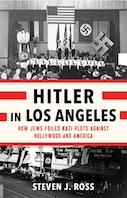
Purchase in the Truthdig Bazaar
Historian Steven Ross has taken a giant step in that direction with his outstanding and compelling book, “Hitler in Los Angeles: How Jews Foiled Nazi Plots Against Hollywood and America.” In his prologue, Ross reveals the deeply personal origins of this work. He discloses his second-generation Holocaust background, declaring, “It is now time to honor my parents and the millions of Jews who found themselves terrorized by Nazis and fascists, not just in Europe but also in the United States.”
This book focuses on the Jewish resistance in Los Angeles to the alarmingly large number of Nazis and fascists in the city during the 1930s and ’40s, before the Dec. 7, 1941, Japanese attack on Pearl Harbor and the formal U.S. entry into World War II. In particular, it is a carefully documented story of Leon Lewis, a Jewish lawyer who organized and supervised an amazingly courageous group of Jewish and non-Jewish spies and infiltrators who undermined the Nazi and fascist plots and activities in the area. “Hitler in Los Angeles” is a major contribution to Jewish history, regional history and American history.
Click here to read long excerpts from “Hitler in Los Angeles” at Google Books.
Very few people, presumably, had heard of the full extent of Nazi penetration of the Los Angeles area after the 1933 Hitler takeover in Germany. Even fewer had heard of Leon Lewis and his anti-Nazi exploits before professor Ross published his book. Ross engagingly presents these dual narratives in his accessible and informative work for both academic and general readers. Parts of “Hitler in Los Angeles” read almost like a spy novel, except that these events really—and frighteningly—happened.
The Nazi and fascist presence in Greater Los Angeles at the time was huge, incorporating numerous organizations, prominent individuals and meeting places. More generally, it was an era of extensive anti-Semitism in the United States as well as in Southern California. This was, after all, the America of Henry Ford, the car manufacturer but also the author of the infamous “The International Jew.” As Ross notes, the weekly radio anti-Semitic rants of Father Charles Coughlin reached 14 million people. For years, Coughlin spread his venom, often attacking “Jewish bankers” and supporting Adolf Hitler and Benito Mussolini. Finally, before the start of World War II, the America First organization with its star performer, famed aviator and Nazi sympathizer Charles Lindbergh, attracted large audiences throughout the country, many members of which were anti-Semitic while others were sincerely opposed to American participation in European wars.
Evangelist Gerald D. Winrod, another fascist demagogue from that time, also spread anti-Jewish propaganda to appreciative audiences throughout the country. William Dudley Pelley, whose fascist Silver Shirts organization’s brown-shirted members believed in a perverse combination of anti-communism, anti-Semitism and mysticism, added to this fearful atmosphere. These groups (The German American Bund, the Silver Shirts, the Ku Klux Klan, the American Nationalist Party and others) regularly promoted the fraudulent “Protocols of the Elders of Zion” as well as other bigoted materials, some originating from Nazi Germany itself.
This was the Depression period, when poverty and unemployment were rampant, and human misery and desperation were the inevitable results. As in Germany, thousands of Americans, including some disaffected World War I veterans, sought scapegoats for their personal plights, blaming Jews and President Franklin Roosevelt’s New Deal (the “Jew Deal”) for the economic crisis and their personal misfortunes. In the Los Angeles area, anti-Semitism was deeply entrenched. Restrictive covenants and “gentlemen’s agreements” kept Jews from purchasing homes in specific areas of the city. Jews were excluded from major commercial and social clubs and organizations. High-ranking members of the police and sheriff’s departments were openly racist and anti-Semitic, often consorting with Nazi and fascist organizations and leaders.
“Hitler in Los Angeles” chronicles the key players in this espionage drama. The “rogues gallery” of players included Hermann Schwinn, the western director of the German American Bund; Paul Themlitz, owner of the Aryan Bookstore; Frantz Ferentz, the main distributor of German films and newsreels on the Pacific Coast; Mrs. Leslie Fry, a chief financier of Nazi and fascist publications and activities in Los Angeles; Dr. Konrad Burchardi, a militant Nazi and physician to German General Consul Georg Gyssling; and many others.
Gyssling was one of the most intriguing and complex figures of the time. He was the Third Reich’s representative in Los Angeles. Among his duties was to monitor the film industry in Hollywood, and to challenge and block any film that had anti-German content or even implications. For a long time, he succeeded massively in that role. The Jewish studio heads despised him for his interference. But while he was a patriotic German, Gyssling personally detested Hitler and was seriously mistrusted by local Nazis and fascists. Most significantly, Ross discovered that he had a longtime Jewish friend, Julius Klein, to whom he divulged valuable information about the Hitler regime.
The various Nazi and fascist groups had regular meeting places, including Deutsches Haus, the Aryan and Continental bookstores, the Ku Klux Klan Meeting Hall, and Hindenburg Park in La Crescenta (finally renamed in 2017 after intense and protracted community pressure), where in 1939, Ross reports, 6,000 men, women and children dressed in traditional German costumes or even Nazi uniforms turned out to celebrate German Day. But beyond their meetings and rallies, local Nazis had carefully constructed objectives to steal weapons from government sources, engage in sabotage, and most insidiously, murder Jewish residents of Los Angeles by shootings and public hangings. Some of their targets included highly prominent Jews from the entertainment and professional communities.
Some local Nazis and fascists even harbored ideas about overthrowing the United States government itself and installing a “Christian America,” modeled presumably on the Third Reich. They had cadres consisting of fanatic men, some with actual military experience in Europe and the U.S. They hoped for violent uprisings in San Diego, San Francisco, and throughout the entire West Coast. While their plans for mass murder were all too real and dangerous, the actual treasonous replacement of the FDR administration was fantasy—though certainly not to be taken lightly.
Leon Lewis, a World War I veteran and former national executive secretary of the Anti-Defamation League, with his chief assistant, journalist Joseph Roos, created the spy network that helped defeat the domestic Nazi threat. Lewis’ organizational skills and experiences made him a master ringleader for the tasks that he and his team undertook.
Arriving in Los Angeles from Chicago, Lewis assembled his team of spies and infiltrators, all but one of whom were not Jewish. They burrowed deeply into local Nazi and fascist groups, reporting regularly to Lewis and Roos. Some were German-born, and their knowledge of the language gave them enormous credibility. Some were military veterans, both of the German and American armed forces. Their undercover work was heroic and tremendously dangerous; detection could have easily resulted in their deaths. As the author reports, some had frighteningly close calls during their escapades in the Ku Klux Klan, the Silver Shirts and the German American Bund. They were sometimes suspected of being spies and had to maneuver delicately.
These heroic men and one woman obtained extensive inside information, such as plans for sabotage and violent acts, including murder, and personal and organizational conflicts within the Southern California Nazi and fascist movements. They were also supremely effective in sowing serious discord within the fascist groups, reducing their effectiveness and even disrupting their pernicious plans. Those parts of the book are exciting, even thrilling, to read, and inspire an enormous respect for these otherwise ordinary people who risked their lives to fight for democracy and decency against some of the most insidious domestic forces that ever assembled in the United States.
The actions of Lewis and Roos require us to change the way we think about American Jewish resistance in the 1930s until the end of World War II. That consciousness would be a valuable antidote to the still widespread notion of Jewish passivity during that era. “Without ever firing a weapon,” Ross writes, “they managed to keep Los Angeles and its citizens safe.”
The overall historical story, however, is more complex. That is not a critique of “Hitler in Los Angeles”; it is, rather, a recognition that the profound issues raised by this book deserve further inquiry into their contemporary implications. As Ross reveals, the Los Angeles-based Nazis in the 1930s reserved special venom for the Jewish leaders of the film studios in Hollywood. These studio bosses were targets of local Nazis and the studio heads were justifiably concerned, both personally and commercially.
The book reveals that the moguls provided some financial support to the spy operation of Lewis and Roos. Their financially strapped operation needed this support. But it is important to remember that the film producers, above all else, were part of the American capitalist apparatus and were accordingly committed to profit, not ideology or even moral decency. As Ross reports, Hollywood contributions to the spymasters slowed down as industry leaders turned their attention to defeating Upton Sinclair when he ran for governor of California in 1934.
This is hugely significant. Sinclair, a longtime socialist and author of such novels as “The Jungle,” centered his campaigned on his EPIC program, End Poverty in California. He called for a massive public works program; public ownership of farms and factories idle during the Depression; major tax reform targeting the rich; a special tax on the highly profitable film industry; and guaranteed pensions for the elderly. Jewish Hollywood moguls turned on Sinclair, producing distorted newsreels to frighten voters, ensuring that he lost the election. That—far more than domestic Nazis and fascists—reflected their class interests.
Throughout their efforts, Lewis and Roos reported the activities of local Nazis to government officials, even though the government provided little or no support in such clandestine undercover espionage operations. One of the agencies to which they sent reports was the House Un-American Activities Committee (HUAC), which held hearings throughout the country including Los Angeles. But as Ross reports, HUAC spent 75 percent of its time investigating communists and 25 percent focusing on Nazis and fascists. The longtime chair of HUAC, Democratic Rep. Martin Dies of Texas, was far more interested in attacking the New Deal and persecuting real and imagined communists and other leftists. Investigating fascist subversion was swiftly ignored, although that was the agency’s specific responsibility during the late 1930s and early ’40s.
Perhaps “Hitler in Los Angeles” might have noted, even fleetingly, the deeper historical significance of HUAC. Dies paved the way for the long, pernicious record of HUAC in “investigating” leftists and liberals in every field of human endeavor, especially in entertainment, education, government and the professions. HUAC attracted such unsavory members to its operation as Congressmen J. Parnell Thomas, Karl Mundt, Francis Walter and Richard Nixon. It was responsible for destroying thousands of lives during the anti-communist hysteria of the postwar period. Its activities in the early 1960s catalyzed some of the initial student agitation of the era that led to the civil rights and anti-war actions that soon followed.
After reading the book, I was left with the uneasy impression that most German-Americans in Los Angeles (and, by implication, throughout the country) were attracted to the Nazi and fascist groups that the author describes so well. My sense is that there were many non-Jewish Germans who opposed Hitler, just as many Italian-Americans opposed Mussolini, and many Japanese-Americans opposed Tojo. My own experience in progressive movements for over half a century has brought me in contact with numerous activists of German heritage and their WWII era parents whose anti-fascist credentials were impeccable and enduring.
The most powerful impact, I believe, of “Hitler in Los Angeles” is considering its meaning for the present. Today’s Nazis and other white supremacists, to be sure, are different from those of the 1930s and early ’40s. Their posters and paraphernalia of Hitler and other Nazi German leaders are deranged expressions of fascist nostalgia. They have no contemporary dictators to inspire them to model a new white nationalist America. Autocrats like Erdogan, Duterte and even Putin are not in the same league as Hitler.
Today’s American Nazis and fascists—and even some of Donald Trump’s “very fine people”—are dangerous because they are armed and they are vicious. They attack and even murder people, especially people of color; members of the LBGTQ community; immigrants; religious minorities like Muslims, Jews and Hindus; and wonderful young political opponents like Heather Heyer. At their worst, they commit acts of mass terror, as Timothy McVeigh did in the Oklahoma City bombing in 1995, or Dylann Roof in the 2015 Charleston church shooting. They infiltrate police forces and they constitute a malignant presence in American society.
Steven Ross’ book reminds us to be constantly vigilant. While we honor Leon Lewis and his courageous compatriots, our task today is to build a progressive movement that not only repudiates the darkest forces within our midst, but also works relentlessly for the ideals of democracy, racial justice, full equality and genuine dignity for all society’s residents.
Your support matters…Independent journalism is under threat and overshadowed by heavily funded mainstream media.
You can help level the playing field. Become a member.
Your tax-deductible contribution keeps us digging beneath the headlines to give you thought-provoking, investigative reporting and analysis that unearths what's really happening- without compromise.
Give today to support our courageous, independent journalists.
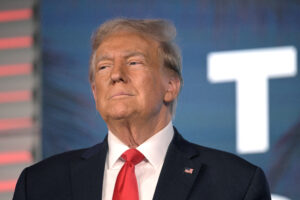
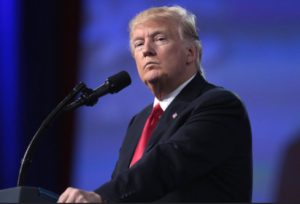
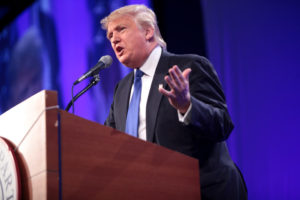
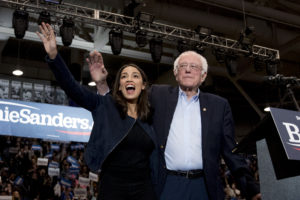
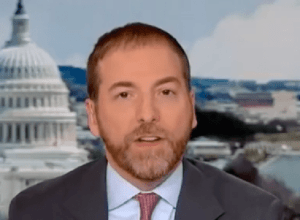
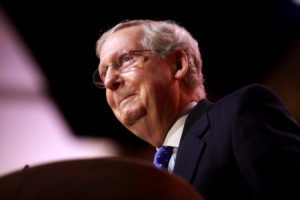
You need to be a supporter to comment.
There are currently no responses to this article.
Be the first to respond.